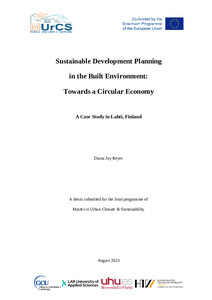Sustainable development planning in the built environment : towards a circular economy : a case study in Lahti, Finland.
Reyes, Diana Joy (2023)
Julkaisun pysyvä osoite on
https://urn.fi/URN:NBN:fi:amk-2023102327810
https://urn.fi/URN:NBN:fi:amk-2023102327810
Tiivistelmä
Amidst increasing human impacts on the environment, particularly through the surge in material consumption, the need for transformative solutions becomes increasingly crucial. The built environment sector, a major resource consumer and waste generator, requires a transition from linear models to circularity. Sustainable development can benefit immensely from Circular Economy (CE) principles, such as waste minimisation and resource efficiency. Essential components for sustainable building stock management and informed policymaking, as noted by Kohler, Steadman, and Hassler (2009), include comprehensive data and evidence, integrated databases, cross-level cooperation, and a long-term outlook. This research uses the city of Lahti as a case study to examine the spatial-temporal trends, current industry practices, and opportunities to incorporate CE principles considering the city’s ambitious goals including Carbon Neutrality by 2025 and a Zero-Waste CE by 2050. The methodology integrates literature reviews, spatio-temporal mapping, and stakeholder interviews and seminars, with a three-phased approach. Phase I involves an analysis of the entire physical built environment while Phase II narrows the focus to residential buildings. Phase III employs a qualitative approach, identifying key themes from literature reviews, interviews, and seminar attendance. The results indicate a substantial existing building stock in Lahti, with higher GFA per resident compared to other major Finnish cities, suggesting potential for qualitative improvement over quantitative expansion. The materials perspective highlighted the shift towards concrete construction. However, emerging opportunities exist to restore the use of bio-based materials such as wood. Furthermore, the analysis from stakeholder perspectives reflected an inclination towards sustainability, balanced with economic viability and regulatory efficiency, while identifying collaboration, innovation, and digitalisation as key enablers necessitating cross-sectoral efforts. The study highlights the extent and complexity of the built environment sector and argues that cities hold significant potential to either alleviate or exacerbate environmental strain based on their development approaches. Recommendations include revitalising underused assets, optimising policies, employing digital solutions, and emphasising inclusion for systemic transformation. While this research focuses on Lahti, the findings and methodologies present a template for other cities seeking to align their built environment sectors with CE principles. Future research opportunities include exploration of the nexus between climate and resource crises, understanding of urban metabolism, examination of building stock turnover rates, and examining best practices from similar cities or countries.
